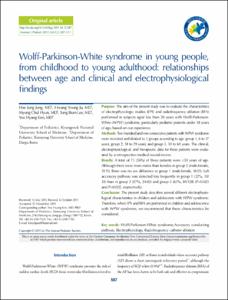Wolff-Parkinson-White syndrome in young people, from childhood to young adulthood: relationships between age and clinical and electrophysiological findings
- Keimyung Author(s)
- Kim, Yeo Hyang
- Department
- Dept. of Pediatrics (소아청소년학)
- Journal Title
- Korean Journal of Pediatrics
- Issued Date
- 2011
- Volume
- 54
- Issue
- 12
- Keyword
- Wolff-Parkinson-White syndrome; Accessory conducting pathway; Electrophysiology; Radiofrequency catheter ablation
- Abstract
- Purpose: The aim of the present study was to evaluate the characteristics of electrophysiologic studies (EPS) and radiofrequency ablation (RFA)
performed in subjects aged less than 30 years with Wolff-Parkinson-White (WPW) syndrome, particularly pediatric patients under 18 years of age, based on our experience. Methods: Two hundred and one consecutive patients with WPW syndrome were recruited and divided to 3 groups according to age: group 1, 6 to 17 years; group 2, 18 to 29 years; and group 3, 30 to 60 years. The clinical, electrophysiological, and therapeutic data for these patients were evaluated by a retrospective medical record review. Results: A total of 73 (36%) of these patients were <30 years of age. Although there were more males than females in group 2 (male:female, 31:11), there was no sex difference in group 1 (male:female, 16:15). Left accessory pathway was detected less frequently in group 1 (32%, 10/31) than in group 2 (57%, 24/42) and group 3 (63%, 81/128) (P=0.023 and P=0.002, respectively). Conclusion: The present study describes several different electrophysiological
characteristics in children and adolescents with WPW syndrome. Therefore, when EPS and RFA are performed in children and adolescence
with WPW syndrome, we recommend that these characteristics be considered.
- Keimyung Author(s)(Kor)
- 김여향
- Publisher
- School of Medicine
- Citation
- Hae Jung Jung et al. (2011). Wolff-Parkinson-White syndrome in young people, from childhood to young adulthood: relationships between age and clinical and electrophysiological findings. Korean Journal of Pediatrics, 54(12), 507–511. doi: 10.3345/kjp.2011.54.12.507
- Type
- Article
- ISSN
- 1738-1061
- Appears in Collections:
- 1. School of Medicine (의과대학) > Dept. of Pediatrics (소아청소년학)
- 파일 목록
-
-
Download
 oak-aaa-03522.pdf
기타 데이터 / 550.92 kB / Adobe PDF
oak-aaa-03522.pdf
기타 데이터 / 550.92 kB / Adobe PDF
-
Items in Repository are protected by copyright, with all rights reserved, unless otherwise indicated.